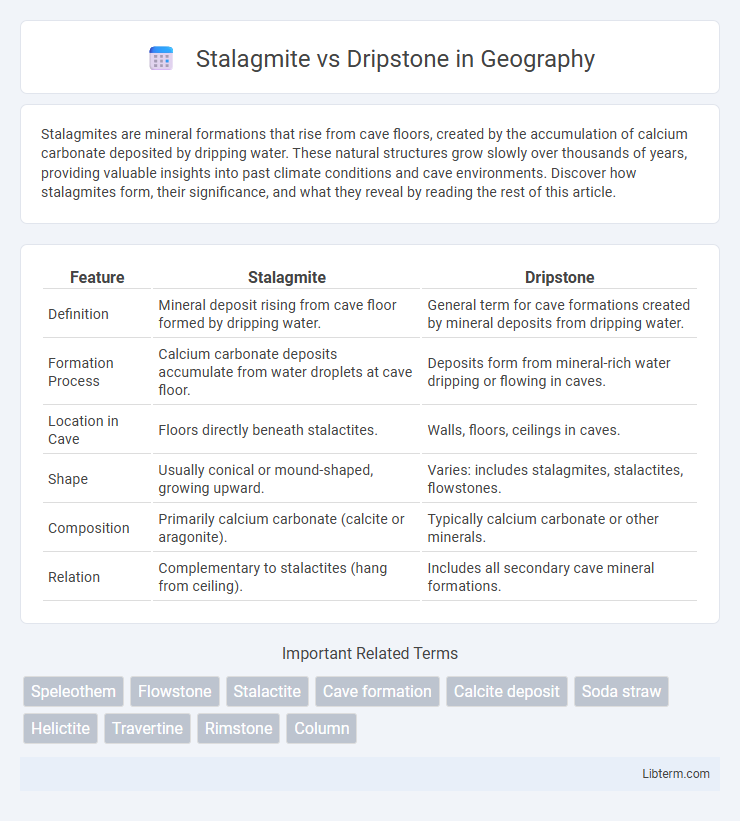Stalagmites are mineral formations that rise from cave floors, created by the accumulation of calcium carbonate deposited by dripping water. These natural structures grow slowly over thousands of years, providing valuable insights into past climate conditions and cave environments. Discover how stalagmites form, their significance, and what they reveal by reading the rest of this article.
Table of Comparison
| Feature | Stalagmite | Dripstone |
|---|---|---|
| Definition | Mineral deposit rising from cave floor formed by dripping water. | General term for cave formations created by mineral deposits from dripping water. |
| Formation Process | Calcium carbonate deposits accumulate from water droplets at cave floor. | Deposits form from mineral-rich water dripping or flowing in caves. |
| Location in Cave | Floors directly beneath stalactites. | Walls, floors, ceilings in caves. |
| Shape | Usually conical or mound-shaped, growing upward. | Varies: includes stalagmites, stalactites, flowstones. |
| Composition | Primarily calcium carbonate (calcite or aragonite). | Typically calcium carbonate or other minerals. |
| Relation | Complementary to stalactites (hang from ceiling). | Includes all secondary cave mineral formations. |
Introduction to Stalagmites and Dripstones
Stalagmites are vertical mineral formations that rise from cave floors, primarily composed of calcium carbonate deposited by dripping water. Dripstones encompass both stalagmites and stalactites, which form through the gradual accumulation of minerals from mineral-rich water seeping through limestone caves. These speleothems provide key geological insights into cave environments and paleoclimate conditions.
Formation Processes: Stalagmite vs Dripstone
Stalagmites form through the gradual accumulation of mineral deposits, primarily calcium carbonate, dripping from cave ceilings and building up from the floor over time. Dripstone refers to the broader category of speleothems formed by mineral-laden water dripping, including both stalagmites and stalactites. While stalagmites specifically grow upward from cave floors, dripstone encompasses all formations created by the precipitation of carbonate minerals from dripping water.
Key Geological Differences
Stalagmites are upward-growing mineral formations found on cave floors, formed by the accumulation of calcium carbonate deposits from dripping water. Dripstone encompasses both stalagmites and stalactites, representing mineral deposits created by dripping or flowing water in caves, often composed primarily of calcite or aragonite. The key geological difference lies in their orientation and formation process: stalagmites rise from the ground due to dripping mineral-rich water, while dripstones include all drip-activated speleothems regardless of their growth direction.
Physical Characteristics and Identification
Stalagmites are upward-growing mineral formations found on cave floors, typically conical or rounded with a wider base, composed primarily of calcite or aragonite deposited from dripping water. Dripstone is a broader term that includes both stalagmites and stalactites, characterized by mineral deposits formed from carbonate-saturated water dripping or flowing in caves. Identification of stalagmites focuses on their floor growth and shape, whereas dripstone identification requires noting the location and formation process, encompassing various speleothem structures.
Common Locations in Nature
Stalagmites typically form on cave floors beneath limestone ceilings where mineral-rich water drips consistently, commonly found in karst caves worldwide such as those in the Mammoth Cave system in Kentucky. Dripstones, including stalactites and stalagmites, occur in similar environments where calcium carbonate precipitates from dripping water, frequently appearing in limestone caves like Carlsbad Caverns in New Mexico. Both formations thrive in humid, stable conditions with continuous mineral deposition, often decorating underground chambers rich in calcite deposits.
Composition and Mineral Content
Stalagmites primarily consist of calcium carbonate in the form of calcite or aragonite, formed from mineral-rich water droplets that deposit minerals on cave floors. Dripstones encompass both stalagmites and stalactites, composed mainly of calcite or other carbonate minerals like gypsum, created by the precipitation of dissolved minerals from dripping water. The mineral content in both features reflects the geochemistry of the groundwater, often dominated by calcium, carbonate ions, and trace elements influencing crystal structure and coloration.
Growth Rates and Environmental Factors
Stalagmites typically grow at rates ranging from 0.1 to 10 millimeters per year, influenced by factors such as water drip rate, mineral saturation, and cave temperature. Dripstone formations, encompassing both stalagmites and stalactites, depend heavily on environmental conditions including humidity, carbon dioxide concentration, and availability of calcium carbonate. Variations in these environmental elements directly affect the precipitation of calcite, thereby determining the growth speed and size of stalagmites within limestone caves.
Scientific Importance and Research Applications
Stalagmites, composed primarily of calcium carbonate deposited from mineral-rich water dripping onto cave floors, serve as valuable paleoclimate archives, recording historical climate conditions through their growth layers. Dripstones encompass both stalagmites and stalactites, acting as critical proxies in speleothem research to analyze isotopic variations and trace elements that reveal past environmental changes. Understanding the formation and composition of stalagmites and other dripstones enables scientists to reconstruct ancient atmospheric CO2 levels and hydrological cycles, contributing significantly to geochronology and climate science.
Stalagmites and Dripstones in Cave Exploration
Stalagmites, formed from mineral-rich water droplets accumulating on cave floors, are key indicators of geological processes in cave exploration, often growing upward as calcium carbonate deposits build layer by layer. Dripstones, encompassing both stalagmites and stalactites, represent essential formations created by the deposition of calcite or aragonite from dripping water, providing valuable insights into cave microclimates and hydrology. Understanding the development and characteristics of stalagmites aids speleologists in reconstructing past environmental conditions and monitoring ongoing cave dynamics.
Conservation and Preservation Efforts
Conservation efforts for stalagmites prioritize minimizing human contact and controlling cave environments to prevent damage and contamination. Dripstone preservation involves regulating water flow and mitigating pollutants to maintain natural mineral deposition processes. Both require careful monitoring to protect geological formations from erosion, vandalism, and changes in cave microclimates.
Stalagmite Infographic

 libterm.com
libterm.com